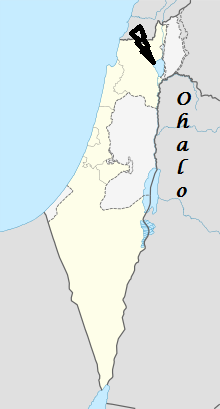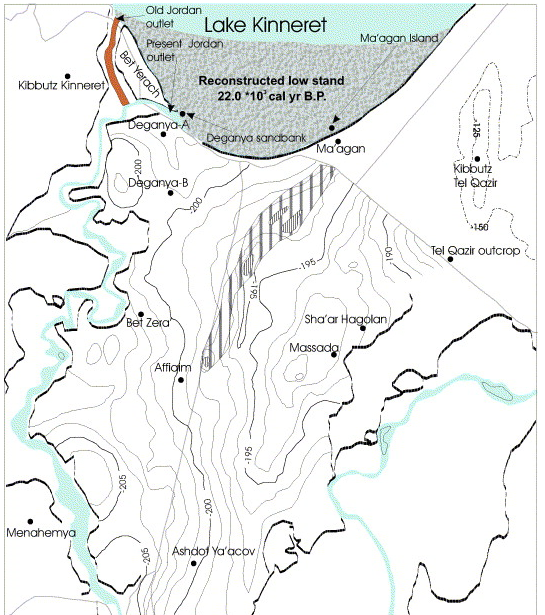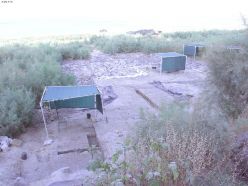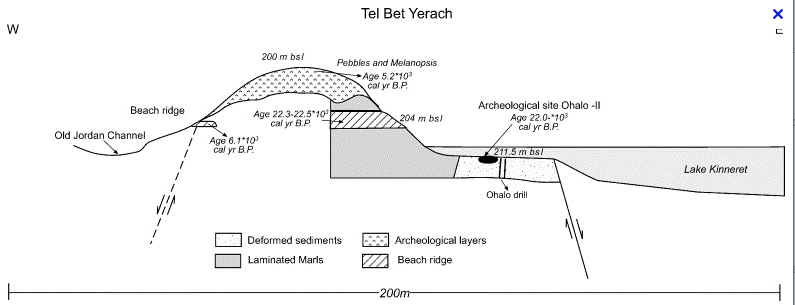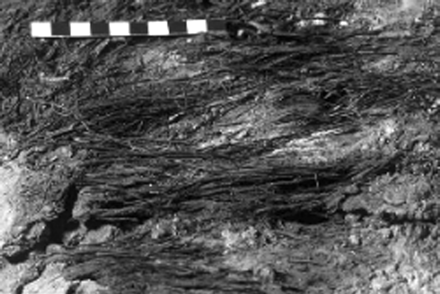It looks like you're using an Ad Blocker.
Please white-list or disable AboveTopSecret.com in your ad-blocking tool.
Thank you.
Some features of ATS will be disabled while you continue to use an ad-blocker.
share:
The encampment known as Ohalo II, found on the sea of Galllilee has provided a good look at how early foragers lived 23kya.
The well preserved site has given examples of what people were eating and how they lived.
A new paper shows that it is likely that the people were in the beginning stages of agriculture.
First Evidence of Farming
Ohalo
Ohalo
A link to Hanslune's thread on Ohalo
The well preserved site has given examples of what people were eating and how they lived.
A new paper shows that it is likely that the people were in the beginning stages of agriculture.
Until now, researchers believed farming was "invented" some 12,000 years ago in the Cradle of Civilization -- Iraq, the Levant, parts of Turkey and Iran -- an area that was home to some of the earliest known human civilizations. A new discovery by an international collaboration of researchers from Tel Aviv University, Harvard University, Bar-Ilan University, and the University of Haifa offers the first evidence that trial plant cultivation began far earlier -- some 23,000 years ago.
Early gatherers
The site bears the remains of six shelters and a particularly rich assemblage of plants. Upon retrieving and examining approximately 150,000 plant specimens, the researchers determined that early humans there had gathered over 140 species of plants. These included 13 known weeds mixed with edible cereals, such as wild emmer, wild barley, and wild oats.
The researchers found a grinding slab -- a stone tool with which cereal starch granules were extracted -- as well as a distribution of seeds around this tool, reflecting that the cereal grains were processed for consumption. The large number of cereals showing specific kinds of scars on their seeds indicate the likelihood of those cereals growing in fields, and the presence of sickle blades indicates that these humans deliberately planned the harvest of cereal.
The new study offers evidence that early humans clearly functioned with a basic knowledge of agriculture and, perhaps more importantly, exhibited foresight and extensive agricultural planning far earlier than previously believed.
First Evidence of Farming
Ohalo
Ohalo is the common designation for the archaeological site Ohalo II in the vicinity of the Sea of Galilee, and one of the best preserved hunter-gatherer archaeological sites of the Last Glacial Maximum, having been radiocarbon dated to around 19,400 BP.[1] The site is significant because of the numerous fruit and cereal grain remains preserved therein, (intact ancient plant remains being exceedingly rare finds due to their quick decomposition).
Organic remains at Ohalo II[edit]
Archeologists have conducted an exhaustive study of Hut 1 at Ohalo II; this hut yielded over 90,000 seeds. The seeds account for more than 100 species of wild barley and fruits. Such a high concentration of seeds in the hut makes it highly unlikely that they were accidentally deposited into the hut via natural forces such as wind. In addition, statistical analysis demonstrates that the concentration of plant matter was significantly higher around the walls than the center. Had the seeds been deposited by the collapsed roof, they would have evenly scattered on the ground. Furthermore, just 13 species of fruit and cereal make up about half of the total number of seeds found in the area; these include brome grains (Bromus pseudobrachystachys), wild barley (Hordeum spontaneum) and millet grass grains (Piptatherum holciforme), just to name a few. This suggests a marked preference of certain species of edible plants. A seed of particular interest comes from the Rubus fruit, which was fragile, difficult to transport, and preferably eaten immediately after collection. The presence of Rubus seeds at the Ohalo II site could indicate that the seeds were dried in the sun or by the fire for storage: early evidence for advanced planning of plant food consumption. Most importantly, the extremely high concentration of seeds clustering around the grinding stone in the northern wall of Hut 1 led archeologist Ehud Weiss to believe that humans at Ohalo II processed the grain before consumption. The exact spatial distribution of the seed around a grinding stone further indicates extensive preparation. The seeds were scattered in a U-shape around the grinding stone, Weiss hypothesized that a woman was squatting at the open end of the U, and actively distributing the seeds all around her while grinding.[9]
Ohalo
A link to Hanslune's thread on Ohalo
a reply to: punkinworks10
You posted this just to bust my balls about my earlier comment regarding agriculture and drunks at Gobekli Tepe right?
Im just kidding. This is actually pretty impressive and corroborates some earlier work I had read a couple of months ago that at the time, was much more speculative but this ties it up pretty neatly with a bow showing that the Levant was the incubator for the starter kit of agriculture. It looks like it probably spread West and North around the same time. The number of seeds they found is really difficult to argue with. I'm definitely going to keep an eye on this and see what else they come up with. Thanks for posting this my friend. We're pushing the clock back on innovation just a little more each day it seems.
You posted this just to bust my balls about my earlier comment regarding agriculture and drunks at Gobekli Tepe right?
Im just kidding. This is actually pretty impressive and corroborates some earlier work I had read a couple of months ago that at the time, was much more speculative but this ties it up pretty neatly with a bow showing that the Levant was the incubator for the starter kit of agriculture. It looks like it probably spread West and North around the same time. The number of seeds they found is really difficult to argue with. I'm definitely going to keep an eye on this and see what else they come up with. Thanks for posting this my friend. We're pushing the clock back on innovation just a little more each day it seems.
a reply to: peter vlar
It is a very important finding, I might ask the reaserchers if this is true agriculture or is a case of horticulture?, at its oldest I believe that is the case, just as it was among the pre agriculture Native americans, southern Chinese and the jomon, they tended wild plants to make them more productive and over the course of time the species became domesticated. The dense oak forests of the California foothills are a product of the NC's tending the trees and clearing under growth to promote acorn production.
A few years ago I pondered a thread about how the fig was the first domesticated plant, its native range was in NE Africa, Ethiopia, and it spread in time with the human movement out of east Africa, into Arabia and the levant.
It is a very important finding, I might ask the reaserchers if this is true agriculture or is a case of horticulture?, at its oldest I believe that is the case, just as it was among the pre agriculture Native americans, southern Chinese and the jomon, they tended wild plants to make them more productive and over the course of time the species became domesticated. The dense oak forests of the California foothills are a product of the NC's tending the trees and clearing under growth to promote acorn production.
A few years ago I pondered a thread about how the fig was the first domesticated plant, its native range was in NE Africa, Ethiopia, and it spread in time with the human movement out of east Africa, into Arabia and the levant.
The new study offers evidence that early humans clearly functioned with a basic knowledge of agriculture and, perhaps more importantly, exhibited foresight and extensive agricultural planning far earlier than previously believed.
I'm not reading anything here that suggests farming. Just that people collected and ate seeds. All the plants named were wild and edible. Agriculture changes the plants as farmers choose the seeds from the best plants to sow, which over time increase the yield.
edit on 23-7-2015 by Marduk because: (no reason given)
People probably harvested long before true "agriculture".
They probably noticed that in certain areas, at certain times, certain edible plants grew. They probably just went to those same spots and harvested them over and over.
These patches of edible plants may have even influenced migratory patterns.
Eventually, someone (most likely a female) figured out that if you buried some of the plants, more plants grew. Yay, we can take our plants where ever we go!
Now you have true agriculture.
They probably noticed that in certain areas, at certain times, certain edible plants grew. They probably just went to those same spots and harvested them over and over.
These patches of edible plants may have even influenced migratory patterns.
Eventually, someone (most likely a female) figured out that if you buried some of the plants, more plants grew. Yay, we can take our plants where ever we go!
Now you have true agriculture.
edit on 23-7-2015 by MystikMushroom because: (no reason given)
edit on 23-7-2015 by
MystikMushroom because: (no reason given)
a reply to: Marduk
But wouldn't that be the possible point of the cache of seeds they had? Though the flip side of that could be that the plants they harvested had entirely decomposed but because of the shell, the seeds were all that remained. I'd have to see the context in which they were found and how it was all stored to get a better idea.
But wouldn't that be the possible point of the cache of seeds they had? Though the flip side of that could be that the plants they harvested had entirely decomposed but because of the shell, the seeds were all that remained. I'd have to see the context in which they were found and how it was all stored to get a better idea.
Assyrians and Israelites are the same people, religion seperates them.
I just felt my butt being raped by this information, so how much did this cost Harvard? Seems all bets are off.
Parsi are the choosen people in the bible not jews, Jews and Assyrians are the same people.The choosen are of indian decent, so are the Sumerians. The Sumerians were fire worshiper, they teaching of making a fire came from the culture of northern Europe. With a group of blonde and blue eyed personas.
Jesus was portrayed by the Jew Borga as a blonde and blue eyed persona, before that most knowledge of his existence portray him as of dark color.
Parsi are the choosen people in the bible not jews, Jews and Assyrians are the same people.The choosen are of indian decent, so are the Sumerians. The Sumerians were fire worshiper, they teaching of making a fire came from the culture of northern Europe. With a group of blonde and blue eyed personas.
Jesus was portrayed by the Jew Borga as a blonde and blue eyed persona, before that most knowledge of his existence portray him as of dark color.
edit on 23-7-2015 by wacco because: (no reason given)
a reply to: Harte
From Hans' thread which I have already linked in OP,
From Hans' thread which I have already linked in OP,
originally posted by: Hanslune
Ohalo II is the name of a previously submerged late Upper Paleolithic site on southwest shore of the Sea of Galilee or Lake Kinneret. It reflects the Kebaran culture and containing the floors and wall bases of six oval brush huts, six open-air hearths and a human grave. Much of the soft materials survived, since it had been submerged, it provided very rare evidence of food sources for late Upper Paleolithic habitation sites.
Animals represented by bones in the faunal assemblage include fish, tortoise, birds, hare, fox, gazelle, and deer.
Link to a general summary about the the site
Location of Ohalo II
A site drawing of the site
Eight wooden objects were found at Ohalo II, a submerged and well-preserved site in the Sea of Galilee, Israel. The fisher-hunter-gatherers' site has been radiometrically dated to 22,500-23,500 (cal BP) with 45 assays read by four laboratories. One incised wooden object is identical in size and incision pattern to a gazelle bone implement found in a grave, behind a human skull. The recovered wooden objects are not directly related to hunting, gathering, or fishing, and frustratingly, there are no remains of bows, arrows, spears, handles, or other such items. Nonetheless, the objects present a wide repertoire in terms of size, shape, and possible function. The new finds add to the growing body of evidence concerning the use of perishable materials during the Upper Paleolithic.
Detail map of the southern area of lake Galilee
At the dig where you can see the receded shore line
Side diagram of the site
The preserved bedding
PDF on the bedding discovered at Ohalo II
Reconstruction of a hut at Ohalo II
PDF on the human remains found at Ohalo II
PDF on the grains and fibre's found at the site
PDF on wooden objects found at the site
Link to a site that briefly covers what they ate at Ohalo II
the sea-of-galilee huts were a product of the silk-road trade route
I would point out that the Sahara desert of today also was once a part of a North African-to- Central African series of trade routes...
(I think the page has a major typo here with the 5,000 year ago statement it probably meant to say 50,000 years ago)
I submit that an intense investigation might reveal that the Levant located grain/seed/production site that is dated 23,000 years ago is probably a copy or a later franchise facility from the much earlier Sahara region grain/seed producers who provided cultivated plant seeds to other far flung destinations south of the present day African desert
just a idea I mull over as the contrarian I am
for reference, the site of the snip is: www.thunderbolts.info...
I would point out that the Sahara desert of today also was once a part of a North African-to- Central African series of trade routes...
...The sands of the Sahara hold many secrets.
It wasn’t always a vast desolate ocean of sand; around 5,000 years ago it was a very different terrain.
It was a sub-tropical paradise where deer, hippos and elephants were hunted and giraffes and rhinoceros roamed the area. With a plentiful supply of food, thousands of hunter-gatherers flocked to live in this lush savannah...
(I think the page has a major typo here with the 5,000 year ago statement it probably meant to say 50,000 years ago)
I submit that an intense investigation might reveal that the Levant located grain/seed/production site that is dated 23,000 years ago is probably a copy or a later franchise facility from the much earlier Sahara region grain/seed producers who provided cultivated plant seeds to other far flung destinations south of the present day African desert
just a idea I mull over as the contrarian I am
for reference, the site of the snip is: www.thunderbolts.info...
edit on rd31143767648323342015 by St Udio because: (no reason given)
IIRC, no grinding slab was mentioned in that old thread.
Also, I don't remember it stating that there was evidence the grains were harvested with scythes, which is important regarding judging the stage of agricultural development that may have existed at the time.
Harte
Also, I don't remember it stating that there was evidence the grains were harvested with scythes, which is important regarding judging the stage of agricultural development that may have existed at the time.
Harte
More on Ohalo
the grind stone

Milling before Agriculture
A grave from Ohalo
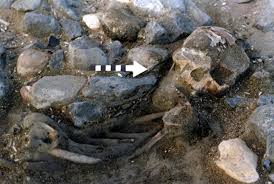
and seed samples
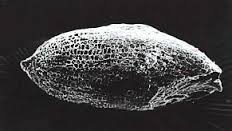

the grind stone

Milling before Agriculture
Paleolithic populations of hunter-gatherers. If animal remains are often found, it is rare that one can get an idea of the vegetable part of the diet. Hence the interest of the recent discovery of Ohalo II Site (Israel) , dated by radiocarbon with mass spectrometry to 19 000 years BP 14C, which corresponds to a calendar age of 23,000 years cal BP 14C .
Over 90,000 remains of 142 different plant species have been found, including 19 000 seeds of grasses. The Ohalo II hunter-gatherers so consumed a large amount of diverse grasses , particularly species with small grains (16,000 remains constituting 35% of the volume) but also wild cereals (65% of the volume because the grains are larger ). The seeds were preserved because they were charred in fires of human origin.
The vegetable diet occupants Ohalo II consisted of barley and emmer (wheat) Wild, acorns (oak Mount Tabor), fruits and berries (olives, wild grapes, wild figs, raspberries, jujubes), pistachios, wild almonds, Boraginaceae and composed, and brought vitamins, trace elements, carbohydrates and fats. Proteins were mostly of animal origin. Although they require a long process to extract the small grain grasses would form the basis of food because all those of Ohalo II were ripe.
Dani Nadel and his team also found 150 starch grains on a large flat stone forty centimeters long which thus turns out to be a millstone. Twenty of these grains corresponds to the wild barley. The people of this site, which belong to the kebarienne Culture (culture of the Middle East above the Natufian), thus producing the flour of wild barley there 23,000 years , ie 12 000 years before the Neolithic.
Finally, archaeologists discovered an oven a few meters from the wheel: there we cooked bread?
According to the theory of the broad spectrum revolution , the important diversification of food, already noted elsewhere feed and proven to Ohalo II for plants, represent a prelude to agriculture. But they found more plant remains at Ohalo II at the level of posterior sites.
The "Neolithic" was in any case probably slower than expected: the transition from gathering to agriculture was based on plants already known and exploited for a long time.
________________________________________
- Daryl Habel (2005) Forum Palanth : Reply # 5 (6 January 2005)
- Dani Nadel (2004) "Wild barley harvesting, fishing, and year-round occupancy at Ohalo II (19.5 KY, Jordan Valley, Israel)". In : Section 6: The Upper Palaeolithic (General Sessions and Posters) Acts of the XIVth Congress UISSP, University of Liege (September 2001). BAR International Series 1240, pp.135-143. -
François Cordellier (2004) The evolution Rights in the XXI century press review in serial form.
- For science No. 324 (2004) page 16 : "The first bread"
- Research # 378 (2004) page 21 : "There are 23 000 years is already operating grain " - Ehud Weiss (2005) "The harvest before agriculture,"
La Recherche No. 382 page 62-65.
_______________________
Sarah Mason thinks he has found in a home in Dolni Vestonice ( 26 000 BP ) indices of manufacture of flour or boiled vegetable based.
_______________________
Millers before agriculture
Summary "Cultures"
Previous Page
Summary "Paleoanthropology"
(C) Dani Nadel
Dani Nadel and Ella Werker
Millers 12,000 years before agriculture
Top: the wheel found in the soil of one of the huts Ohalo II. The control
e: the "hut # 1", restored by Dani Nabel and Ella Werker of after analysis of coals and drawing huts Kalahari and Australia. The floor of Ohalo II huts widened slightly. Part of the floor is covered with plants, probably for sleeping : it would be the oldest known bed.
A grave from Ohalo

and seed samples


edit on p0000007k40742015Thu, 23 Jul 2015 13:40:59 -0500k by punkinworks10 because: spelling
originally posted by: peter vlar
a reply to: Marduk
But wouldn't that be the possible point of the cache of seeds they had? Though the flip side of that could be that the plants they harvested had entirely decomposed but because of the shell, the seeds were all that remained. I'd have to see the context in which they were found and how it was all stored to get a better idea.
Its the seeds that you grind to make flour...
edit on 23-7-2015 by Marduk because: (no reason given)
We all know this is total bull#, the knowledge of agriculture in that time era, would mean knowledge about seasons, some astronomy. They were a
nomadic semitic people.
originally posted by: wacco
We all know this is total bull#, the knowledge of agriculture in that time era, would mean knowledge about seasons, some astronomy. They were a nomadic semitic people.
Semite is named after the language which didn't reach this region for another 18,000 years
originally posted by: wacco
We all know this is total bull#, the knowledge of agriculture in that time era, would mean knowledge about seasons, some astronomy.
And we all know that Nomads can't tell the difference between snow and rain, nor do they ever look up at the sky.
Harte
new topics
-
Australian PM says the quiet part out loud - "free speech is a threat to democratic dicourse"...?!
New World Order: 1 minutes ago -
Ireland VS Globalists
Social Issues and Civil Unrest: 32 minutes ago -
Biden "Happy To Debate Trump"
Mainstream News: 1 hours ago -
RAAF airbase in Roswell, New Mexico is on fire
Aliens and UFOs: 1 hours ago -
What is the white pill?
Philosophy and Metaphysics: 2 hours ago -
Mike Pinder The Moody Blues R.I.P.
Music: 3 hours ago -
Putin, Russia and the Great Architects of the Universe
ATS Skunk Works: 6 hours ago -
A Warning to America: 25 Ways the US is Being Destroyed
New World Order: 10 hours ago
top topics
-
President BIDEN's FBI Raided Donald Trump's Florida Home for OBAMA-NORTH KOREA Documents.
Political Conspiracies: 16 hours ago, 35 flags -
A Warning to America: 25 Ways the US is Being Destroyed
New World Order: 10 hours ago, 18 flags -
Mike Pinder The Moody Blues R.I.P.
Music: 3 hours ago, 7 flags -
What is the white pill?
Philosophy and Metaphysics: 2 hours ago, 5 flags -
Biden "Happy To Debate Trump"
Mainstream News: 1 hours ago, 5 flags -
RAAF airbase in Roswell, New Mexico is on fire
Aliens and UFOs: 1 hours ago, 4 flags -
Putin, Russia and the Great Architects of the Universe
ATS Skunk Works: 6 hours ago, 3 flags -
Ireland VS Globalists
Social Issues and Civil Unrest: 32 minutes ago, 2 flags -
Australian PM says the quiet part out loud - "free speech is a threat to democratic dicourse"...?!
New World Order: 1 minutes ago, 0 flags
active topics
-
Biden "Happy To Debate Trump"
Mainstream News • 18 • : underpass61 -
Ireland VS Globalists
Social Issues and Civil Unrest • 3 • : nugget1 -
Australian PM says the quiet part out loud - "free speech is a threat to democratic dicourse"...?!
New World Order • 0 • : FlyInTheOintment -
What is the white pill?
Philosophy and Metaphysics • 16 • : BrotherKinsMan -
Putin, Russia and the Great Architects of the Universe
ATS Skunk Works • 22 • : SchrodingersRat -
Candidate TRUMP Now Has Crazy Judge JUAN MERCHAN After Him - The Stormy Daniels Hush-Money Case.
Political Conspiracies • 793 • : matafuchs -
University of Texas Instantly Shuts Down Anti Israel Protests
Education and Media • 279 • : cherokeetroy -
Is AI Better Than the Hollywood Elite?
Movies • 22 • : 5thHead -
King Charles 111 Diagnosed with Cancer
Mainstream News • 324 • : Oldcarpy2 -
President Biden is Angry at A.G. Merrick Garland for Not Being Loyal to the Biden Family.
Above Politics • 20 • : WeMustCare

